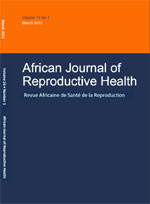
|
African Journal of Reproductive Health
Women's Health and Action Research Centre
ISSN: 1118-4841
Vol. 19, No. 3, 2015, pp. 61-67
|
 Bioline Code: rh15036
Bioline Code: rh15036
Full paper language: English
Document type: Research Article
Document available free of charge
|
|
|
African Journal of Reproductive Health, Vol. 19, No. 3, 2015, pp. 61-67
| fr |
Harfouche, Melike; Hosseinipour, Mina; Kaliti, Stephen & Wilkinson, Jeffrey
Résumé
L'objectif de cette étude est d'identifier les indicateurs de qualité de césariennes et de déterminer leur relation à la morbidité et la mortalité néonatale et maternelle dans un hôpital de la maternité de volume élevé à Lilongwe, au Malawi. Démographique, périopératoire, et les données post-opératoires ont été recueillies sur tous les accouchements par césarienne plus de trois mois. Indicateurs de qualité (l'administration d'antibiotiques, l'utilisation de l'ocytocine, l e temps de décision à l'incision, et de l'utérus de type d'incision) ont été comparés à de morbidité maternelle (hémorragie post-partum, la fistule et infection de la plaie) et la mortalité néonatale. Les causes de retards dans la prise à l'incision du temps ont été identifiés. 513 césariennes ont été effectuées au cours de la période de l'étude, aucun décès maternels et 39 décès néonatals. l'adhésion à l'ocytocine et l'administration d'antibiotiques était haute mais pas complet, avec une plus grande adhésion à l'ancien (97,1% vs 82,6%). La décision d'incision de temps entre les femmes avec et sans décès néonatals était similaire (1,62 vs 1,49 heures heures, p = 0,41). La plupart des retards ont été attribués à un théâtre chargé d'exploitation (49,1%) et le transfert retardé au théâtre d'exploitation (26,9%). La rupture utérine et l'hystérectomie césarienne ont été associées à un résultat de décès néonatal (p <0,001). Infrastructure et du personnel des limitations sont des obstacles majeurs à l'amélioration de la qualité des accouchements par césarienne. Les efforts futurs vers amélioration de la qualité doivent combler ces lacunes. (Afr J Reprod Health 2015; 19[3]: 61-67).
Mots Clés
obstétrique; internationale; de qualité; à faible ressource
|
| |
| en |
Quality Indicators and Outcomes of Emergency Caesarean Deliveries at a District-level Maternity Hospital
Harfouche, Melike; Hosseinipour, Mina; Kaliti, Stephen & Wilkinson, Jeffrey
Abstract
The objective of this research study is to identify quality indicators of cesarean deliveries and determine their relationship to neonatal and maternal morbidity and mortality in one high volume maternity hospital in Lilongwe, Malawi. Demographic, perioperative, and postoperative data were collected on all cesarean deliveries over three months. Indicators of quality (antibiotic administration, use of oxytocin, decision-to-incision time, and uterine incision type) were compared to maternal morbidities (postpartum hemorrhage, fistula and wound infection) and neonatal mortality. Causes of delays in decision to incision time were identified. 513 cesarean deliveries were performed during the study period, with no maternal deaths and 39 neonatal deaths. Adherence to oxytocin and antibiotic administration was high but not complete, with greater adherence to the former (97.1% vs 82.6%). The decision to incision time between women with and without neonatal deaths was similar (1.62 hours vs 1.49 hours, p=0.41). Most delays were attributed to a busy operating theatre (49.1%) and delayed transfer to the operating theatre (26.9%). Uterine rupture and cesarean hysterectomy were associated with an outcome of neonatal death (p<0.001). Infrastructure and personnel limitations are major barriers to the improvement of quality of cesarean deliveries. Future endeavors towards quality improvement must address these deficiencies. (Afr J Reprod Health 2015; 19[3]: 61-67).
Keywords
obstetrics; international; quality; low resource
|
| |
© Copyright 2015 - African Journal of Reproductive Health
Alternative site location: http://www.ajrh.info
|
|
